Mountain Tapir
Tapirus pinchaque
Status: Endangered

Also Known As
Tapir de montaña, danta conga, danta de páramo, danta lanuda
Characteristics
Though it is the smallest (and furriest!) of tapir species, the Mountain tapir is the largest mammal in the tropical Andes mountain range. Their long hair is brownish to black, and their lips are lined in a white color. Adults have two characteristic hair-free patches on their rump.
Mountain tapirs are 1.8 meters long, 0.8 meters high, and weigh between 150 and 250 Kilos. As with all tapir species, their young have a “watermelon” patterned camouflage coat.

Illustration generously provided by Stephen Nash, Conservation International
Mountain Tapir Range Map

Map by Carlos Pedraza, Tapir Specialist Group, 2008
Habitat and Range
Mountain tapirs are found in Colombia, Ecuador and northern Peru. Their habitat is montane forests, “paramos,” or high, treeless plateaus, and “cloud forests,” a wet, tropical mountain forest almost constantly covered by clouds. Mountain tapirs are found between 2000 and 4000 meters of elevation.
Threats to Their Survival
The primary threats to the mountain tapir are warfare and habitat loss due to poppy farming and growth of ranching and agriculture, driven by human population growth in the Andean region. Hunting is no longer a major threat due to local regulations and increased awareness of this species’ rarity and conservation status.
Population Estimate (2008): Exact numbers are not known as more research is needed, but estimated population is more than 2,500 individuals. Numbers are decreasing.
Other Mountain Tapir Facts
These strong creatures are well adapted to travelling through forested hills and thriving in the harsh weather conditions of the high Andes. Like other tapir species, the mountain tapir is comfortable in water and can swim well. They also have a very developed sense of smell and hearing.
Mountain tapirs are solitary, and their activity is mainly between the first hours of dusk and first hours after sunrise. They are more active in colder temperatures than on warm days.
The mountain tapir feeds on leaves, twigs and fruits of a large number of plant species in Andean forests. The tapirs are important seed dispersers and a key component for the maintenance of the structure and composition of montane forests in South America.
Sources
Lizcano, D. J., A. Guarnizo, J. A. Suarez, F. K. Florez, and O. Montenegro. 2006. Danta de paramo Tapirus pinchaque. in J. V. Rodriguez-Maecha, M. Alberico, F. Trujillo, and J. Jorgenson, editors. Libro rojo de los mamíferos de Colombia. Serie libros rojos de especies amenazadas de Colombia.
Conservación Internacional, Colombia & Ministerio de Ambiente, Vivienda y Desarrollo Territorial, Bogota, Colombia.
Morales-Jiménez A.L., Sánchez F., K Poveda & A. Cadena. 2004. Mamíferos terrestres y voladores de Colombia. Guía de Campo. Bogotá, Colombia. 248 p.
Ministerio de Ambiente, Vivienda y Desarrollo Territorial, Viceministerio de Ambiente, Dirección de Ecosistemas. 2005. Programa Nacional para la Conservación del Género Tapirus en Colombia.
Written with help from Diego Lizcano, TSG, and Juliana Rodriguez, TSG
